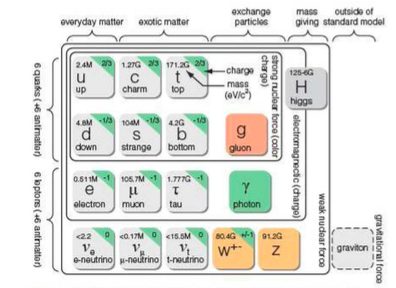Introduction to the Fundamental Particles
What you should know
⇒ Matter is made of atoms
⇒ In the centre of the atom there is a nucleus (made of protons and neutrons). Around the nucleus there are electrons
⇒ Atoms are electrically neutral - there are the same number of protons (positively charged) and electrons (negatively charge), and their charges balance each other out.
⇒ Protons and neutrons are about 1800 times larger than an election, which means that most the mass of an atom is concentrated in the nucleus
Discovering Particles
⇒ Three sub-atomic particles - the electron, proton, and neutron - were all discovered around the beginning of the twentieth century
⇒ In the 1930s new sub-atomic particles were discovered (such as the positron and muon)
⇒ The war had led to huge advances in technology and science, meaning more discoveries could be made
⇒ It soon became apparent that sub-atomic particles were being discovered and could be grouped together (like the elements on the periodic table)

⇒ It is incredibly simple in that there are just two families of fundamental particles (quarks and leptons) and a set of forces that bind them together
The Standard Model
⇒ In 1967 the Standard Model of matter (seen above) was first constructed, and it gives us the current picture of the structure and behaviour of matter. In essence, it is the basic system of fundamental particles and forces that make up the universe. It contains all the quarks, leptons, exchange particles and the fundamental forces.
Mass of fundamental particles
⇒ The mass of a fundamental particle is almsot always given as mass-energy equivalents
- Mass-energy equivalence states that anything having mass has an equivalent amount of energy and vice versa, with these fundamental quantities directly relating to one another by Albert Einstein's famous formula
⇒ Remember, Einstein's equation E = mc2 can be arranged to m = E / c2, s
- Because the speed of light is a very large number in everyday units, the formula implies that even an everyday object at rest with a modest amount of mass has a very large amount of energy intrinsically
⇒ Rest mass-energies can therefore be given as a mass (usually in MeV/c2) or an energy equivalent (usually in MeV)
Fundamental Particles
⇒ Fundamental particles are the basic building blocks of the universe, and cannot be broken down into smaller pieces
⇒ The discovery of fundamental particles began with JJ Thomson's discovey of the electron and has led us to our seemingly complete Standard Model of 12 fundamental particles
⇒ The 12 fundamental particles and the 4 exchange particles that hold them together can be rearranged to create essentially any particle in the universe
⇒ It appears that the vast majority of the universe is made of just three fundamental particles: the electron, the up quark, and the down quark
⇒ Protons and neutrons are constructed of up and down quarks bundled togehter in threes
- Protons are made from two up quarks and one down quark. Neutrons are made from two down quarks and one up quark
Extra
⇒ Also see our notes on: